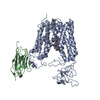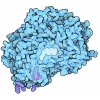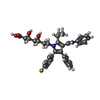+ Open data
Open data
- Basic information
Basic information
| Entry | Database: PDB / ID: 9cy3 | |||||||||||||||||||||
|---|---|---|---|---|---|---|---|---|---|---|---|---|---|---|---|---|---|---|---|---|---|---|
| Title | Outward-facing Atorvastatin-bound OATP1B1 with sybody Sb5 | |||||||||||||||||||||
 Components Components |
| |||||||||||||||||||||
 Keywords Keywords | TRANSPORT PROTEIN / solute carrier / sybody / membrane protein / drug-drug interactions | |||||||||||||||||||||
| Function / homology |  Function and homology information Function and homology informationDefective SLCO1B1 causes hyperbilirubinemia, Rotor type (HBLRR) / Organic anion transport by SLCO transporters / sodium-independent organic anion transport / : / thyroid hormone transmembrane transporter activity / prostaglandin transmembrane transporter activity / heme catabolic process / Atorvastatin ADME / organic anion transport / : ...Defective SLCO1B1 causes hyperbilirubinemia, Rotor type (HBLRR) / Organic anion transport by SLCO transporters / sodium-independent organic anion transport / : / thyroid hormone transmembrane transporter activity / prostaglandin transmembrane transporter activity / heme catabolic process / Atorvastatin ADME / organic anion transport / : / bile acid transmembrane transporter activity / Heme degradation / bile acid and bile salt transport / Recycling of bile acids and salts / monoatomic ion transport / xenobiotic metabolic process / basal plasma membrane / basolateral plasma membrane / membrane / plasma membrane Similarity search - Function | |||||||||||||||||||||
| Biological species |  Homo sapiens (human) Homo sapiens (human)synthetic construct (others) | |||||||||||||||||||||
| Method | ELECTRON MICROSCOPY / single particle reconstruction / cryo EM / Resolution: 3.2 Å | |||||||||||||||||||||
 Authors Authors | Sung, M.W. / Lees, J.A. / Han, S. | |||||||||||||||||||||
| Funding support |  United States, 1items United States, 1items
| |||||||||||||||||||||
 Citation Citation |  Journal: J Biol Chem / Year: 2025 Journal: J Biol Chem / Year: 2025Title: Cyclosporine A sterically inhibits statin transport by solute carrier OATP1B1. Authors: Min Woo Sung / Kuan Hu / Lea M Hurlimann / Joshua A Lees / Kimberly F Fennell / Mark A West / Chester Costales / Amilcar David Rodrigues / Iwan Zimmermann / Roger J P Dawson / Shenping Liu / Seungil Han /   Abstract: Members of the Organic Anion Transporter Polypeptides (OATP) are integral membrane proteins responsible for facilitating the transport of organic anions across the cell membrane. OATP1B1 (SLCO1B1), ...Members of the Organic Anion Transporter Polypeptides (OATP) are integral membrane proteins responsible for facilitating the transport of organic anions across the cell membrane. OATP1B1 (SLCO1B1), the prototypic OATP family member, is the most abundant uptake transporter in the liver and a key mediator of the hepatic uptake and clearance of numerous endogenous and xenobiotic compounds. It serves as a locus of important drug-drug interactions, such as those between statins and cyclosporine A, and carries the potential to enable liver-targeting therapeutics. In this study, we report cryo-EM structures of OATP1B1 and its complexes with one of its statin substrates, atorvastatin, and an inhibitor, cyclosporine A. This structural analysis has yielded insights into the mechanisms underlying the OATP1B1-mediated transport of statins and the inhibitory effect of cyclosporine A. These findings contribute to a better understanding of the molecular processes involved in drug transport and offer potential avenues for the development of targeted medications for liver-related conditions. | |||||||||||||||||||||
| History |
|
- Structure visualization
Structure visualization
| Structure viewer | Molecule:  Molmil Molmil Jmol/JSmol Jmol/JSmol |
|---|
- Downloads & links
Downloads & links
- Download
Download
| PDBx/mmCIF format |  9cy3.cif.gz 9cy3.cif.gz | 130.8 KB | Display |  PDBx/mmCIF format PDBx/mmCIF format |
|---|---|---|---|---|
| PDB format |  pdb9cy3.ent.gz pdb9cy3.ent.gz | 96.2 KB | Display |  PDB format PDB format |
| PDBx/mmJSON format |  9cy3.json.gz 9cy3.json.gz | Tree view |  PDBx/mmJSON format PDBx/mmJSON format | |
| Others |  Other downloads Other downloads |
-Validation report
| Summary document |  9cy3_validation.pdf.gz 9cy3_validation.pdf.gz | 1.3 MB | Display |  wwPDB validaton report wwPDB validaton report |
|---|---|---|---|---|
| Full document |  9cy3_full_validation.pdf.gz 9cy3_full_validation.pdf.gz | 1.3 MB | Display | |
| Data in XML |  9cy3_validation.xml.gz 9cy3_validation.xml.gz | 29 KB | Display | |
| Data in CIF |  9cy3_validation.cif.gz 9cy3_validation.cif.gz | 41.4 KB | Display | |
| Arichive directory |  https://data.pdbj.org/pub/pdb/validation_reports/cy/9cy3 https://data.pdbj.org/pub/pdb/validation_reports/cy/9cy3 ftp://data.pdbj.org/pub/pdb/validation_reports/cy/9cy3 ftp://data.pdbj.org/pub/pdb/validation_reports/cy/9cy3 | HTTPS FTP |
-Related structure data
| Related structure data |  46005MC  9cy1C  9cy4C M: map data used to model this data C: citing same article ( |
|---|---|
| Similar structure data | Similarity search - Function & homology  F&H Search F&H Search |
- Links
Links
- Assembly
Assembly
| Deposited unit | 
|
|---|---|
| 1 |
|
- Components
Components
| #1: Protein | Mass: 79880.977 Da / Num. of mol.: 1 Source method: isolated from a genetically manipulated source Source: (gene. exp.)  Homo sapiens (human) / Gene: SLCO1B1, LST1, OATP1B1, OATP2, OATPC, SLC21A6 / Production host: Homo sapiens (human) / Gene: SLCO1B1, LST1, OATP1B1, OATP2, OATPC, SLC21A6 / Production host:  Homo sapiens (human) / References: UniProt: Q9Y6L6 Homo sapiens (human) / References: UniProt: Q9Y6L6 |
|---|---|
| #2: Protein | Mass: 15885.510 Da / Num. of mol.: 1 Source method: isolated from a genetically manipulated source Source: (gene. exp.) synthetic construct (others) / Production host:  |
| #3: Chemical | ChemComp-117 / |
| Has ligand of interest | Y |
| Has protein modification | Y |
-Experimental details
-Experiment
| Experiment | Method: ELECTRON MICROSCOPY |
|---|---|
| EM experiment | Aggregation state: PARTICLE / 3D reconstruction method: single particle reconstruction |
- Sample preparation
Sample preparation
| Component | Name: Outward-facing atorvastatin-bound OATP1B1 with Sybody 5 Type: COMPLEX / Entity ID: #1-#2 / Source: RECOMBINANT |
|---|---|
| Source (natural) | Organism:  Homo sapiens (human) Homo sapiens (human) |
| Source (recombinant) | Organism:  Homo sapiens (human) Homo sapiens (human) |
| Buffer solution | pH: 7.5 |
| Specimen | Embedding applied: NO / Shadowing applied: NO / Staining applied: NO / Vitrification applied: YES |
| Vitrification | Cryogen name: ETHANE |
- Electron microscopy imaging
Electron microscopy imaging
| Experimental equipment |  Model: Titan Krios / Image courtesy: FEI Company |
|---|---|
| Microscopy | Model: FEI TITAN KRIOS |
| Electron gun | Electron source:  FIELD EMISSION GUN / Accelerating voltage: 300 kV / Illumination mode: FLOOD BEAM FIELD EMISSION GUN / Accelerating voltage: 300 kV / Illumination mode: FLOOD BEAM |
| Electron lens | Mode: BRIGHT FIELD / Nominal defocus max: 2200 nm / Nominal defocus min: 600 nm |
| Image recording | Electron dose: 60 e/Å2 / Film or detector model: TFS FALCON 4i (4k x 4k) |
- Processing
Processing
| EM software | Name: PHENIX / Category: model refinement | ||||||||||||||||||||||||
|---|---|---|---|---|---|---|---|---|---|---|---|---|---|---|---|---|---|---|---|---|---|---|---|---|---|
| CTF correction | Type: PHASE FLIPPING AND AMPLITUDE CORRECTION | ||||||||||||||||||||||||
| 3D reconstruction | Resolution: 3.2 Å / Resolution method: FSC 0.143 CUT-OFF / Num. of particles: 127971 / Symmetry type: POINT | ||||||||||||||||||||||||
| Refine LS restraints |
|
 Movie
Movie Controller
Controller





 PDBj
PDBj









